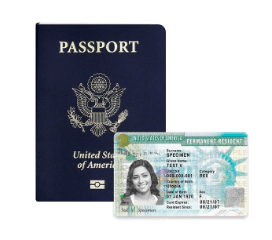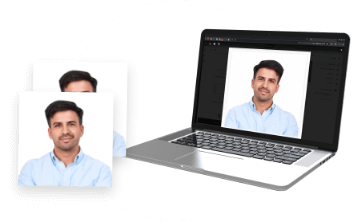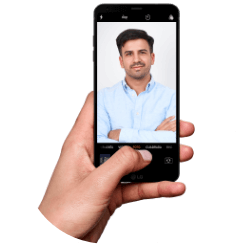Why download our APP?
If taking Passport Photos has become a difficult process for you and your family, we recommend that you download our Passport Photos App and get a seamless, error-proof experience thanks to mobile technology and our experts.

Questions?
Is iVisa.com a legitimate company?
Our Company is accredited and recognized by the International Air Transport Association (IATA) and has a validated IATA Agency Code. If you want to check this information you can verify our membership using our bearing No. 23716873 at http://store.iata.org/ieccacfree.
Remember that the customer service team at iVisa.com is here 24/7 to answer any questions you may have about our service.
Get Your Biometric Photos Online Now!
The need for a biometric photo has increasingly become popular. Modern-day passports, visas, and many other documents prefer its use over the old-style photos because it provides more reliable verification information of the document holder’s identity and improves security by minimizing fraud possibilities.
Biometrics started back in the past with recorded use in 1858 by Sir William Herschel when he was working for the Civil Service of India. What he did was he put each worker’s handprint on the back of a contract in an effort to make sure that workers are identified accordingly. This was the first identification technique that used a systematic capture of hand and finger images.
Many years later, Alphonse Bertillon (1870) developed a method of individual identification by using detailed records of physical descriptions, body measurements, and photos. This was referred to as Bertillonage which was used by law enforcement agencies but was soon abolished because of inconsistencies with its results.
A lot of other developments took place throughout the years and one of the most notable of which is Woodrow W. Bledsoe’s semi-automated face recognition system in the 1960s that relied mainly on the administrator’s ability to extract useable feature points.
Safety and security have since become very important, especially because the latter years have been riddled with a lot of terroristic attacks and crimes against humanity. In an effort to curb the negative results of such crimes, technological and security companies worked for hand in hand with governments to enhance their identification and security systems. They developed state-of-the-art systems that can identify individuals using visible facial information, fingerprints, gait, and other unique features of a person.
Many other things were introduced until more sophisticated hardware and software systems were invented to enhance biometric identification. Today’s technology is in fact more advanced than in the past.
In January 2001, they installed a face recognition system at the Super Bowl in Tampa, Florida, in order to prevent the entry of known criminals in the stadium. Facial recognition soon became very reliable that government agencies all over the world started using it as a new standard for identification and documentation.
In 1994, the Immigration and Naturalization Service Passenger Accelerated Service System (INSPASS) was implemented. It allowed travelers to bypass immigration lines at selected airports throughout the US but they stopped it in 2004. Authorized travelers were issued cards that had their hand geometry information encoded which let them pass through the INSPASS where they present their tokens (cards) with the encoded information and their hands to the biometric device instead of being processed by an Immigration Inspector. The individual will then be allowed to proceed to the customs gate without getting in the queue of long inspection lines. This makes entry to the US faster and more convenient.
With biometric photos becoming a norm in identification and documentation, companies started using the same to identify their workers and customers alike. Even mobile apps use digital photos for additional security and convenience of the user. The revolution of technology today is just so powerful that everyone tends to follow the trend. For example, worldwide immigration offices now mostly require that travel document photos have to meet biometric standards. After all, international travel and traveler safety are sometimes jeopardized because of cultural differences so extra care is necessary. Also, calamities happen everywhere whether we like it or not, and for governments to be able to keep track of, locate and help their citizens, sophisticated technology is often made use of.
It would be very nice to know that you are being taken care of by your government when you are traveling internationally, so is required to submit these advanced identification documents should not be something to hate. You have to comply with your government’s requirements because it is for your own good. You are going out of your country to enjoy other places, do business or work in foreign countries, so you need to always be prepared.
Some people think it is difficult to produce such photos, but that is far front the truth. Preparing a photo for processing is almost the same as taking your favorite selfie with some modifications to make the photo appear clearer and compliant. You will need a high-resolution camera to start with. The camera of your smartphone will work. You can take several shots and choose the best one to use.
In general, the following are the requirements for a biometric photo:
- It has to be no more than one month old.
- It has to be in full color.
- It must be printed on plain white photo paper without borders.
- The background has to be plain off-white or light grey.
- It has to be clear and focused in high definition.
- There should be no creases or tears.
- It has to show a full head and full shoulders.
- There should be no other objects in the background.
The following should also be considered:
- You have to face the camera head-on.
- You must have a neutral expression. Smiles and frowns are not acceptable.
- Your eyes have to be open and must show clearly. Your mouth has to be closed.
- There has to be reflection or glare from. Glasses are preferably removed.
- Hair should not cover the eyes.
- Do away with hair decoration.
- Only headgear required by religion religious or for medical purposes can be used.
- All facial features have to be visible.
- There should be no shadows on the subject or background.
iVisa Photos can help you with your biometric photo needs. We have been helping voyagers and ordinary people alike in getting photos for various purposes for many years now, so we are sure we can provide you with the service that you need. We will deliver your photos that have been processed according to standards and are sure to be compliant. We also have knowledgeable and experienced customer service representatives to help you when necessary.
Types of photo served by iVisa:
Read more about our photo service
- 5 Easy tips to get a perfect passport photo
- Afghanistan Passport/Visa Photo Requirements and size
- Albania Passport/Visa Photo Requirements and size
- Australia Passport / Visa Photo Requirements and Size
- Austria Passport/Visa Photo Requirements and Size
- Azerbaijan Passport / Visa Photo Requirements and Size
- Baby Passport Photo Requirements
- Bahamas Passport/Visa Photo Requirements and Size
- Bahrain Passport/Visa Photo Requirements and Size
- Bangladesh Passport/Visa Photo Requirements and Size
- Barbados Passport/Visa Photo Requirements and Size
- Belarus Passport/Visa Photo Requirements and Size
- Belgium Passport / Visa Photo Requirements and Size
- Belize Passport/Visa Photo Requirements and Size
- Benin Passport/Visa Photo Requirements and Size
- Best ID Photo App
- Best ID Photo Print Service
- Bhutan Passport/Visa Photo Requirements and Size
- Bolivia Passport/Visa Photo Requirements and Size
- Bosnia and Herzegovina Passport/Visa Photo Requirements and Size
- Botswana Passport/Visa Photo Requirements and Size
- Brazil Passport / Visa Photo Requirements and Size
- Brunei Passport/Visa Photo Requirements and Size
- Bulgaria Passport/Visa Photo Requirements and Size
- Burkina Faso Passport/Visa Photo Requirements and Size
- Burundi Passport/Visa Photo Requirements and Size
- Cambodia Passport / Visa Photo Requirements and Size
- Cameroon Passport/Visa Photo Requirements and Size
- Canada Passport / Visa Photo Requirements and Size
- Cape Verde Passport/Visa Photo Requirements and Size
- Chad Passport/Visa Photo Requirements and Size
- Chile Passport/Visa Photo Requirements and Size
- China Passport and Visa Photo: Requirements and Size
- Colombia Passport/Visa Photo Requirements and Size
- Comoros Passport/Visa Photo Requirements and Size
- Comparing the Requirements of Standard ID Photos
- Congo Passport/Visa Photo Requirements and Size
- Costa Rica Passport/Visa Photo Requirements and Size
- Create a Green Card Photo with iVisa Photos
- Create ID Photos with MyPassportPhotos
- Croatia Passport/Visa Photo Requirements and Size
- Cuba Passport/Visa Photo Requirements and Size
- Cyprus Passport/Visa Photo Requirements and Size
- Czech Republic Passport / Visa Photo Requirements and Size
- Denmark Passport / Visa Photo Requirements and Size
- DIY Passport Photo | How to Take Passport Photos at Home
- Djibouti Passport/Visa Photo Requirements and Size
- Dominica Passport/Visa Photo Requirements and Size
- Dominican Republic Passport/Visa Photo Requirements and Size
- East Timor Passport/Visa Photo Requirements and Size
- Ecuador Passport/Visa Photo Requirements and Size
- Egypt Passport/Visa Photo Requirements and Size
- El Salvador Passport/Visa Photo Requirements and Size
- Equatorial Guinea Passport/Visa Photo Requirements and Size
- Eritrea Passport/Visa Photo Requirements and Size
- Estonia Passport/Visa Photo Requirements and Size
- Ethiopia Passport/Visa Photo Requirements and Size
- Fiji Passport/Visa Photo Requirements and Size
- Finland Passport / Visa Photo Requirements and Size
- FOID Card Photo Requirements and Size
- France Passport / Visa Photo Requirements and Size
- Gabon Passport/Visa Photo Requirements and Size
- Gambia Passport/Visa Photo Requirements and Size
- Georgia Passport/Visa Photo Requirements and Size
- Germany Passport / Visa Photo Requirements and Size
- Germany Passport/Visa Photo Requirements and Size
- Ghana Passport / Visa Photo Requirements and Size
- Greece Passport / Visa Photo Requirements and Size
- Green Card and DV Lottery Photos Check Services
- Green Card and DV Lottery Photos Requirements
- Grenada Passport/Visa Photo Requirements and Size
- Guatemala Passport/Visa Photo Requirements and Size
- Guinea-Bissau Passport/Visa Photo Requirements and Size
- Guinea Passport/Visa Photo Requirements and Size
- Guyana Passport/Visa Photo Requirements and Size
- Haiti Passport/Visa Photo Requirements and Size
- Honduras Passport/Visa Photo Requirements and Size
- Hong Kong Passport / Visa Photo Requirements and Size
- How to make ID Photos with iVisa Photos
- Hungary Passport/Visa Photo Requirements and Size
- Iceland Passport/Visa Photo Requirements and Size
- India Passport / Visa Photo Requirements and Size
- Indonesian Passport / Visa Photo Requirements and Size
- Iran Passport/Visa Photo Requirements and Size
- Iraq Passport/Visa Photo Requirements and Size
- Ireland Passport/Visa Photo Requirements and Size
- Israel Passport / Visa Photo Requirements and Size
- Italy Passport / Visa Photo Requirements and Size
- Ivory Coast Passport/Visa Photo Requirements and Size
- Jamaica Passport/Visa Photo Requirements and Size
- Japan Passport / Visa Photo Requirements and Size
- Jordan Passport/Visa Photo Requirements and Size
- Kazakhstan Passport/Visa Photo Requirements and Size
- Kenya Passport / Visa Photo Requirements and Size
- Kiribati Passport/Visa Photo Requirements and Size
- Korea Passport and Visa Photo: Requirements and Size
- Kosovo Passport/Visa Photo Requirements and Size
- Kuwait Passport/Visa Photo Requirements and Size
- Kyrgyzstan Passport/Visa Photo Requirements and Size
- Laos Passport/Visa Photo Requirements and Size
- Latvia Passport/Visa Photo Requirements and Size
- Lebanon Passport/Visa Photo Requirements and Size
- Lesotho Passport/Visa Photo Requirements and Size
- Liberia Passport/Visa Photo Requirements and Size
- Libya Passport/Visa Photo Requirements and Size
- Liechtenstein Passport/Visa Photo Requirements and Size
- Lithuania Passport/Visa Photo Requirements and Size
- Luxembourg Passport/Visa Photo Requirements and Size
- Macedonia Passport/Visa Photo Requirements and Size
- Madagascar Passport/Visa Photo Requirements and Size
- Malawi Passport/Visa Photo Requirements and Size
- Malaysia Passport / Visa Photo Requirements and Size
- Maldives Passport/Visa Photo Requirements and Size
- Mali Passport/Visa Photo Requirements and Size
- Malta Passport/Visa Photo Requirements and Size
- Mauritania Passport/Visa Photo Requirements and Size
- Mauritius Passport/Visa Photo Requirements and Size
- Mexican Passport / Visa Photo Requirements and Size
- Micronesia Passport/Visa Photo Requirements and Size
- Moldova Passport/Visa Photo Requirements and Size
- Monaco Passport/Visa Photo Requirements and Size
- Mongolia Passport/Visa Photo Requirements and Size
- Montenegro Passport/Visa Photo Requirements and Size
- Morocco Passport/Visa Photo Requirements and Size
- Mozambique Passport/Visa Photo Requirements and Size
- Myanmar (Burma) Passport/Visa Photo Requirements and Size
- Namibia Passport/Visa Photo Requirements and Size
- Nauru Passport/Visa Photo Requirements and Size
- NCLEX Application Photo Requirements and Size
- Nepal Passport/Visa Photo Requirements and Size
- Netherlands Passport / Visa Photo Requirements and Size
- New Zealand Passport / Visa Photo Requirements and Size
- Nicaragua Passport/Visa Photo Requirements and Size
- Niger Passport/Visa Photo Requirements and Size
- Nigerian Passport / Visa Photo Requirements and Size
- Norway Passport / Visa Photo Requirements and Size
- Oman Passport/Visa Photo Requirements and Size
- Pakistani Passport / Visa Photo Requirements and Size
- Palau Passport/Visa Photo Requirements and Size
- Panama Passport/Visa Photo Requirements and Size
- Papua New Guinea Passport/Visa Photo Requirements and Size
- Paraguay Passport/Visa Photo Requirements and Size
- Passport Photo Background
- Passport Photo Coupon
- Passport Photo Glasses
- Passport Photo Machine
- Passport Photo Price and Cost Comparison
- Passport Photo Smile
- Peru Passport/Visa Photo Requirements and Size
- Philippines Passport / Visa Photo Requirements and Size
- Poland Passport / Visa Photo Requirements and Size
- Portugal Passport / Visa Photo Requirements and Size
- Qatar Passport/Visa Photo Requirements and Size
- Romania Passport/Visa Photo Requirements and Size
- Russia Passport/Visa Photo Requirements and Size
- Rwanda Passport/Visa Photo Requirements and Size
- Saint Kitts & Nevis Passport/Visa Photo Requirements and Size
- Saint Lucia Passport/Visa Photo Requirements and Size
- Saint Vincent & the Grenadines Passport/Visa Photo Requirements and Size
- Samoa Passport/Visa Photo Requirements and Size
- San Marino Passport/Visa Photo Requirements and Size
- Sao Tome & Principe Passport/Visa Photo Requirements and Size
- Saudi Arabia Passport/Visa Photo Requirements and Size
- Schengen Visa Photo Requirements and European Passport Photo Size
- Senegal Passport/Visa Photo Requirements and Size
- Serbia Passport/Visa Photo Requirements and Size
- Seychelles Passport/Visa Photo Requirements and Size
- Should You Smile in Your Passport Photo?
- Sierra Leone Passport/Visa Photo Requirements and Size
- Singapore Passport / Visa Photo Requirements and Size
- Slovakia Passport/Visa Photo Requirements and Size
- Slovenia Passport/Visa Photo Requirements and Size
- Solomon Islands Passport/Visa Photo Requirements and Size
- Somalia Passport/Visa Photo Requirements and Size
- South African Passport / Visa Photo Requirements and Size
- South Korea Passport/Visa Photo Requirements and Size
- South Sudan Passport/Visa Photo Requirements and Size
- Spain Passport / Visa Photo Requirements and Size
- Sri Lanka Passport and Visa Photo: Requirements and Size
- Start planning trip to Malaysia with Passport photo
- Sudan Passport/Visa Photo Requirements and Size
- Suriname Passport/Visa Photo Requirements and Size
- Swaziland (Eswatini) Passport/Visa Photo Requirements and Size
- Sweden Passport / Visa Photo Requirements and Size
- Switzerland Passport / Visa Photo Requirements and Size
- Syria Passport/Visa Photo Requirements and Size
- Taiwan Passport / Visa Photo Requirements and Size
- Tajikistan Passport/Visa Photo Requirements and Size
- Tanzania Passport / Visa Photo Requirements and Size
- Thailand Passport / Visa Photo Requirements and Size
- The Central African Republic Passport/Visa Photo Requirements and Size
- The Democratic Republic of the Congo Passport/Visa Photo Requirements and Size
- The Marshall Islands Passport/Visa Photo Requirements and Size
- The United Arab Emirates Passport/Visa Photo Requirements and Size
- Togo Passport/Visa Photo Requirements and Size
- Tonga Passport/Visa Photo Requirements and Size
- Trinidad & Tobago Passport/Visa Photo Requirements and Size
- Tunisia Passport/Visa Photo Requirements and Size
- Turkey Passport / Visa Photo Requirements and Size
- Turkmenistan Passport/Visa Photo Requirements and Size
- Tuvalu Passport/Visa Photo Requirements and Size
- Uganda Passport/Visa Photo Requirements and Size
- Ukraine Passport/Visa Photo Requirements and Size
- United Kingdom Passport / Visa Photo Requirements and Size
- United States of America Passport/Visa Photo Requirements and Size
- Uruguay Passport/Visa Photo Requirements and Size
- US Passport / Visa Photo Requirements and Size
- Uzbekistan Passport/Visa Photo Requirements and Size
- Vanuatu Passport/Visa Photo Requirements and Size
- Vatican City Passport/Visa Photo Requirements and Size
- Venezuela Passport/Visa Photo Requirements and Size
- Vietnam Passport and Visa Photo: Requirements and Size
- Yemen Passport/Visa Photo Requirements and Size
- Zambia Passport/Visa Photo Requirements and Size
- Zimbabwe Passport/Visa Photo Requirements and Size
- Algeria Passport/Visa Photo Requirements and size
- Andorra Passport/Visa Photo Requirements and size
- Angola Passport/Visa Photo Requirements and Size
- Antigua and Barbuda Passport/Visa Photo Requirements and Size
- Argentina Passport / Visa Photo Requirements and Size
- Armenia Passport/Visa Photo Requirements and Size
- How to print passport photos with iVisa.com
- China Visa Photo Requirements and Size
- Passport Photo USCIS: How to take the perfect shot
- US Visa photo requirements
- Canada Visa Photo Requirements
- China Visa Photo Requirements
- India Visa Photo Requirements
- UK Visa Photo Requirements
- Australia Visa Photo Requirements
- France Visa Photo Requirements
- Japan Visa Photo Requirements
- Singapore Visa Photo Requirements
- Germany Visa Photo Requirements
- Thailand Visa Photo Requirements
- Malaysia Visa Photo Requirements
- Vietnam Visa Photo Requirements
- New Zealand Visa Photo Requirements
- Cambodia Visa photo requirements
- UAE Visa Photo Requirements
- Italy Visa Photo Requirements
- Netherlands Visa Photo Requirements
- Turkey Visa Photo Requirements
- Spain Visa Photo Requirements













